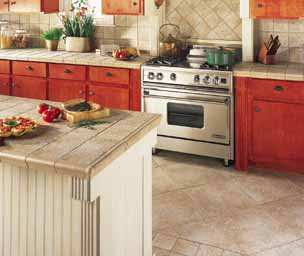|
|
|
||
floor tile
Floor Tile
Floor tiles have graced the vast majority of homes
throughout the United States and Europe for many years now. The range of colors,
designs and textures available today is
limitless, and floor tiles now come in enough sizes and shapes to
satisfy the most discriminating palate. Individual tiles come in squares, rectangles, hexagons, octagons, and various
other shapes that defy description. In fact, some will argue that there are simply just too many
choices. Floor Tile QualityAlthough the country of origin has little to do with the quality of the ceramic tile, the methods used to produce it certainly do. There are various ways of making tile, but I'll group them into only two categories: single fired and multi-fired. Single-fired tiles are the ones you should consider because they are the most durable.In single-fired tiles, the bisque is colored and glazed before it is "cooked" in a kiln at extremely high temperatures, usually 1200 to 1500 degrees Fahrenheit. The result is a hard and durable floor tile, resilient enough to last a lifetime. Because of the extreme temperatures, there is a certain amount of warpage, and the only way of controlling it is by grading the tiles by size after they've left the kiln. Therefore, it is important to ensure that all are from the same lot. In the United States, floor tiles, foreign ones included, are graded according to their resistance to abrasion by the Porcelain Enamel Institute (PEI). The grades (classes) are numbered 1 through 5, with grade 5 being the most resistant. This information is usually not on the packaging, so you'll have to depend on your flooring supplier to provide it, another good reason to stick with a professional supplier. In residential applications, grade III is more than adequate for any traffic area, and grade II might be considered for areas that won't receive the brunt of traffic such as bathroom walls and floors. Multi-fired, even triple-fired tiles, should not be used on floors where heavy traffic is anticipated. They are fired at lower temperatures, and the clay is not as dense as that used in the single-firing method. The glazes, which are not as well bonded as those of single-fired, tend to chip more readily. So, if you want your investment to last indefinitely, choose a more durable one. © 2008 FloorBiz, Inc. All Rights Reserved For additional information on this and other resilient products... FloorBiz is your starting point to all the important flooring sites on the internet. | |||
|
|
|